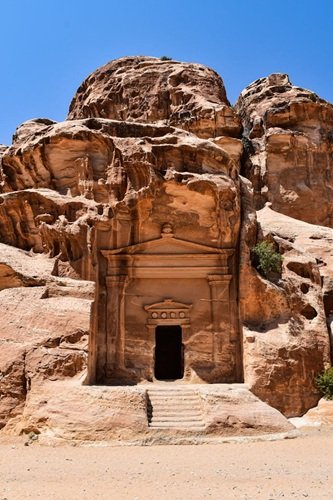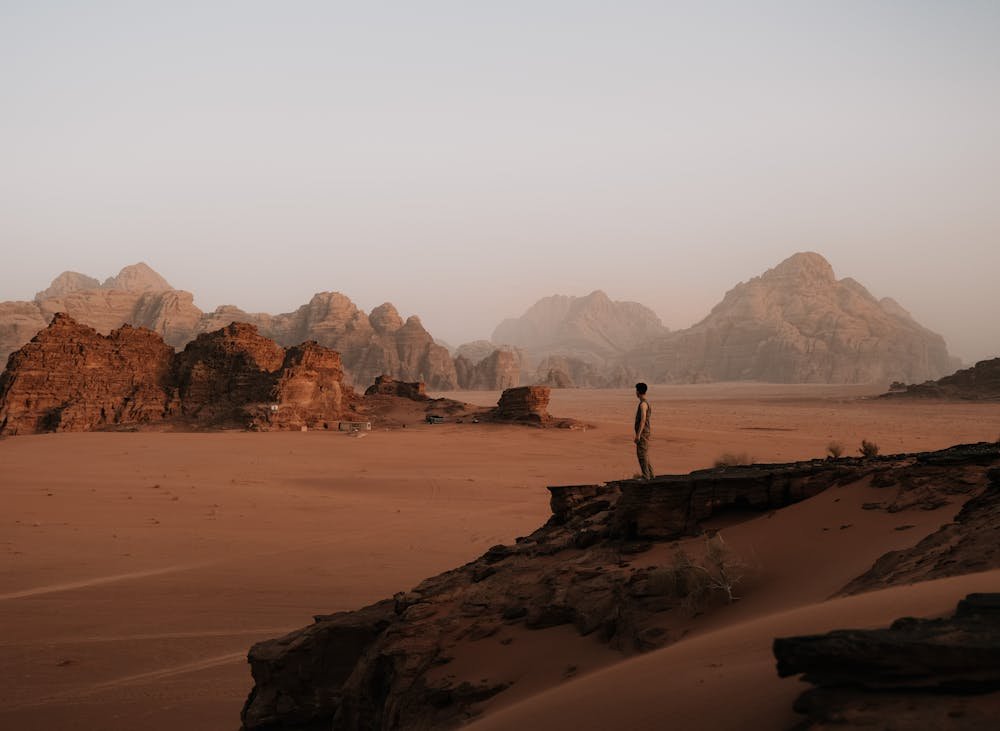Looking places to see in Wadi Rum? Wadi Rum is one of those places that feels like it’s straight out of a dream—or maybe a sci-fi movie.
In other words, it’s this otherworldly desert area in southern Jordan that looks like Mars decided to take a vacation on Earth.
Speaking of which, people have been living here for thousands of years. Whereas the Nabateans (you know, the same folks who built Petra) left behind sculptures and temples here.
Plus, Bedouins still call this place home by living in harmony with the harsh but beautiful environment.
Over time, Wadi Rum has become a bucket-list destination for travelers who are looking to escape the chaos of modern life and connect with something raw and ancient.
So why you must visit here? Well, imagine standing under a sky so clear you can see every star.
In addition to that, imagine climbing red sand dunes that feel like they go forever, or exploring narrow spots by centuries of wind and water.
In fact, this place isn’t just about pretty views—it’s about feeling small in the best way possible.
Moreover, it’s not overrun with tourists like some other places in Jordan.
Therefore, you can really experience the serenity. Whether you’re into hiking, photography, history, or just chilling under billions of stars.
15 Best Places to See in Wadi Rum
Alright, let’s dive into the good stuff: the must-see spots in Wadi Rum.
Trust us, there’s no shortage of fascinating sights here.
Therefore, we’ll walk you through 15 of the best ones, and by the time we’re done, you’ll be curious to pack your bags.
Speaking of which, these places aren’t just about ticking boxes—they’re about creating memories that stick with you forever.
Jebel Um Ishrin

Let’s start with the popular one—literally.
Jebel Um Ishrin is one of the most iconic mountains in Wadi Rum, and it is in fact.
Whereas this towering sandstone giant looks like it was painted by nature itself, with its deep reds, oranges, and browns blending perfectly into the desert below.
To be honest, it’s not just a mountain—it’s an experience.
Speaking of which, you can climb to the top (or part way up if you’re short on time), and you’ll be rewarded with panoramic views of the desert that goes out as far as the eye can see.
Therefore, make sure to bring your camera because this place is perfect to add some photos to your Instagram profile.
Pro tip: Go early morning or late afternoon when the sunlight is golden.
The Seven Pillars of Wisdom
These rock formations are famous for its sheer drama and unique shapes.
Legend has it they were named after T.E. Lawrence’s book, The Seven Pillars of Wisdom.
Whether or not that’s true, these towering pillars are something special.
This is because these are especially stunning at sunset when the low light makes those glow orange and red, almost like those on fire.
Plus, when standing there, you’ll feel like you’ve stepped onto another planet just because of the beauty of it.
Therefore, don’t rush this one—take your time to get in the view and snap plenty of photos if you like.
Lawrence’s Spring
History lovers, this one’s for you.
T.E. Lawrence, in other words, Lawrence of Arabia, reportedly stayed here during his time in the region.
Speaking of which, it’s a small but beautiful spot that is away in the rocks, with a tiny waterfall trickling down into a pool.
In addition to that, the plants surrounding the spring feel like a little miracle in the middle of the desert.
So, once you are here, take a moment to sit under the shade of the trees and imagine what life must have been like for Lawrence back in the day.
Khazali Canyon


If you’re into history or just love a good mystery, Khazali Canyon is a must-visit.
As you walk through the narrow passageway, you’ll come across ancient petroglyphs that are in the rock walls.
Trust us, these drawings tell stories of the people who lived here thousands of years ago, such as hunters, herders, and travelers who were passing through.
Plus, the canyon itself is cool and quiet by giving out a nice break from the heat outside.
Note: It’s also perfect for photos, so don’t forget your camera.
Burrah Canyon
For hikers, Burrah Canyon is a place that you must visit.
Speaking of which, this spot offers a bit of shade and plenty of opportunities to scramble over rocks and explore.
Unlike Khazali, which can get crowded, Burrah is often goes over the site by tourists, so you might just have the place to yourself.
That means more peace, more quiet, and more chances to connect with nature.
Note: If you’re looking for a spot to escape the noise and recharge, this is it.
Umm Fruth Rock Bridge
Picture this: a natural stone arch that is high above the desert ground.
Well, yes, that is what you can find here.
Umm Fruth Rock Bridge is one of those places that makes you stop and say, “Wow.”
Speaking of which, getting there involves a bit of climbing, but trust us, the effort is worth it.
Whereas once you’re up there, the view is absolutely breathtaking.
In other words, you’ll feel like you’re standing on top of the world due to the vibe that you can get there.
And it is also a fantastic spot for photos, so bring your camera and go for a pose.
Siq Al Barid (Little Petra)


Okay, technically this is closer to Petra, but it’s worth mentioning because it gives you a taste of what the Nabateans were all about.
Whereas you can think of narrow canyons, hidden chambers, and detailed carvings.
Plus, Siq Al Barid is like a smaller, quieter version of Petra, minus the crowd.
Therefore, you can easily walk through the passageways, enjoy the craftsmanship, and imagine what life was like for the people who built this place.
Al Hasany Dunes
Desert dunes as far as you can see—well, that’s the best way to describe Al Hasany Dunes in the shortest way.
These golden sands are perfect for sliding down like a kid on a playground.
Whereas you just need to run to the top of a dune, slide down, and let gravity do the rest.
Trust us, it’s fun, it’s freeing, and it’s a great way to feel like a kid again.
But don’t forget to take it all in.
Which means that there’s something incredibly peaceful about standing in the middle of a desert, that is with nothing but sand and sky.
Rakhabat Canyon
This one’s a hidden spot.
Since not many tourists make it here, you’ll likely have the place to yourself.
Speaking of which, Rakhabat Canyon feels like a secret passageway that is in the earth.
Whereas the walls are close enough to touch, and the silence is almost meditative.
In fact, it’s the perfect spot to slow down and appreciate the beauty of simplicity.
Note: Bring a journal or just sit quietly, as it’s a great place to feel calm over here.
Nabatean Temple
History lovers, this is your call again!
Speaking of which, this ancient temple dates back to the Nabatean era, though it’s not as grand as the structures in Petra.
Anyway, still, it’s fascinating to explore and imagine what life was like back then.
In fact, the temple is located in a calm place in the desert by almost blending into the area.
Plus, we are sure that walking around it allows you to feel a sense of awe for the people who built it.
Anfashieh Inscriptions
More ancient carvings, but these ones are particularly well-maintained.
This is because these basically have the touch of animals, people, and scenes from daily life.
It’s like walking through an open-air museum where every carving tells a story.
With that being said, take your time in here to understand the details, where you’ll notice things you might miss at first glance.
Note: It’s a reminder of how connected we are to the past, even in such a remote place.
Jebel Khashmeeleh
This area is filled with rock art and inscriptions by making it a treasure area for anyone who is interested in history or art.
Plus, it’s also a great spot for a leisurely walk.
Anyway, as you walk around, you’ll notice how the area changes with every step.
Whereas the colors, textures, and shapes of the rocks are absolutely fascinating.
In fact, it’s a place that invites you to slow down and pay attention to the little things.
Wadi Rum Village


After all the wilderness, it’s nice to take a break and check out the local village, isn’t it?
Speaking of which, Rum Village is small but full of charm.
Where you can try tea, chat with locals, and learn more about Bedouin culture.
In fact, the people here are warm and welcoming, and they love sharing stories about their way of life.
So, if you think about it, it’s a great opportunity to connect with the community and get a glimpse of what life is like in the desert.
Sunset at Jebel Rum
Watching how the sun dips behind the mountains is a spiritual experience.
As the light fades, the colors shift from gold to pink to deep purple by painting the sky in shades that you didn’t think were possible.
Whereas it’s impossible not to feel awesome.
Anyway, to get the best experience, find a cozy spot to sit, maybe with a cup of tea in hand, and just let the moment wash over you.
Trust us, it’s one of those experiences that reminds you how beautiful the world can be.
Night Sky Stargazing


Last but definitely not least, the night sky in Wadi Rum is quite fascinating.
With no amount of light pollution, you can see the Milky Way in all its glory.
Anyway, to get the best experience, lay back, relax, and let the universe blow your mind.
Whereas the stars feel so close to you that you could almost reach out and touch them.
In other words, it’s a humbling experience—one that makes you realize just how small we are in this world.
Plus, if you’re lucky, you might even catch a shooting star.
Best Time to Visit Wadi Rum
Let’s talk about timing.
Nobody wants to show up in Wadi Rum only to realize it’s hotter than a frying pan, right?
Well, summer temperatures can go above 40°C (104°F), which makes exploring pretty miserable.
Therefore, aim for spring (March to May) or autumn (September to November).
This is because during these months, the weather is mild, the skies are clear, and the desert feels quite magical.
Plus, spring has the added bonus of wildflowers blooming, which adds a pop of color to this sandy area.
Autumn, on the other hand, is the harvest season, so you might get to try some fresh local bites on your way.
Finally, winter (December to February) can be quite average, especially at night, but it’s still a decent time to visit if you don’t mind bundling up.
Note: Just avoid summer unless you’re a fan of sweating.
How to Get to Wadi Rum
Getting to Wadi Rum is easier than you might think.
If you’re starting from Amman, it’s about a 4-hour drive to the south.
Speaking of which, renting a car is an option, but honestly, it’s easier to hire a driver or join a tour.
Anyway, from Aqaba, it’s only about an hour away by making it a great day trip if you’re staying by the Red Sea. And if you’re coming from Petra, it’s roughly a 2-hour drive.
On the other hand, most tours include transportation, so you won’t have to worry about finding ways by yourself.
Plus, having a guide means you’ll learn all sorts of cool facts about the area.
Moreover, if you’re feeling adventurous, you could always rent a jeep once you arrive and explore the area on your own.
Note: Just make sure you have a map and plenty of water to stay hydrated!
Where to Stay in Wadi Rum
Now, where do you crash after a long day of exploring?
Well, there are two main options: like luxury camps or budget stays.
Therefore, let’s break it down.
Luxury camps are the way to go if you want to treat yourself in the most perfect way.
Where you can picture spacious tents with real beds, private bathrooms, and even hot showers.
Plus, some even offer gourmet meals and guided tours. And to be honest, falling asleep under the stars in total comfort is quite magical, right?
On the other hand, budget options are quite average but still awesome.
Whereas you can think of simple tents with shared facilities.
In addition to that, you’ll get the full Bedouin experience without costing you much.
Anyway, always remember that, either way, staying overnight is a must, as waking up to the sunrise over the desert is pretty unforgettable.
Wadi Rum Travel Tips
Before you go, here are some tips to make your trip more perfect.
What to Pack: Sunscreen is non-negotiable. So is a hat, sunglasses, and a reusable water bottle. Plus, comfortable shoes are key since you’ll be doing a lot of walking. Whereas layers of overcoats are smart too, as it can get cold at night.
Safety: Wadi Rum is generally safe, but common sense goes a long way. Therefore, stick to marked trails, listen to your guide, and don’t walk alone. In addition to that, keep an eye on your belongings, especially in crowded areas.
Guides: Hiring a local guide is a smart idea. This is because they know the area inside out and also share fascinating stories and insights. Moreover, supporting local businesses is always a win.
Conclusion
So, there you go. Wadi Rum is one of those places that stays with you long after you’ve left.
This is because its beauty, history, and sheer level of uniqueness leave a mark on your soul.
Therefore, whether you’re chasing adventure or just interested in getting some Insta pics, this desert is a wonderland.
So go ahead and plan that trip, because we know you won’t regret it.
Contact Travelco Holidays to book Jordan tour packages.
FAQs
The Seven Pillars of Wisdom takes the win here. That is because it’s iconic, photo-perfect, and full of history.
Two to three days is ideal. Whereas that gives you enough time to explore the highlights without feeling rushed.
Absolutely! While tours are convenient, independent travelers can rent jeeps and explore on their own.
Yes, it’s quite safe. Anyway, just stick to common-sense precautions and consider hiring a guide for peace of mind.
Light and simple clothing is best for daytime, plus layers of overcoats for cooler nights. Plus, don’t forget your shoes and the hat!


Editorial Staff at Travelco are experts in Global Tourism.

